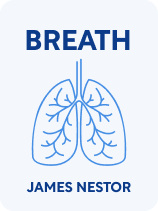

This article is an excerpt from the Shortform book guide to "Breath" by James Nestor. Shortform has the world's best summaries and analyses of books you should be reading.
Like this article? Sign up for a free trial here.
Can you regulate your nervous system through respiration? How can breathwork help you calm down—or stimulate—your mind?
The respiratory system is an opening through which we can consciously influence other autonomic functions. In computer terms, the lungs provide an exploit that we can use to control parts of our bodies that we wouldn’t otherwise have access to, such as the nervous system.
Here’s how you can hack your nervous system by breathing.
Hacking the Nervous System
The lungs interact with two different parts of the autonomic nervous system when breathing. Different nerves are connected to different parts of the lungs, so by making your breath shallower or deeper, you can deliberately trigger different responses in your body. Nestor describes what the different triggers do, how Tibetan monks developed this practice to survive in the frigid Himalayan heights, and how Dutch athlete Wim Hof uses the same techniques to perform incredible acts of endurance.
(Shortform note: Wim Hof’s technique, described in The Wim Hof Method, grew out of his experimentation with combining different breathing practices with exposure to cold water. However, in his book, Hof espouses cold exposure as the first important step before moving on to controlled breathing. He couples both of these to adapting the right mindset, which he says is crucial to obtaining all the benefits of his program.)
According to Nestor, the autonomic nervous system is actively regulated by breathing. It’s broken into two parts: the parasympathetic nervous system, which triggers rest and relaxation, and the sympathetic nervous system, which gears our bodies up for action. The parasympathetic nervous system is connected to the lower parts of our lungs, which is why slow, deep breaths are calming. Conversely, the sympathetic nervous system is tied to the lungs’ upper regions. Short, rapid breaths that only reach the top of the lungs trigger the sympathetic nerves into action, putting your body into a heightened state of stress. Evolution designed that heightened state for our survival, but the body isn’t meant to stay in it for long.
(Shortform note: The sympathetic and parasympathetic nervous systems are located in different parts of the body. The sympathetic system is predominantly centered on the spinal column, while the parasympathetic system is located between the top of the spine and the medulla. Though both systems regulate the same internal organs, the effects they have are different. In general, the sympathetic system increases bodily function, while the parasympathetic system slows down body activity.)
Nestor writes that a breathing technique known as Tummo (or “inner fire”) was developed in Tibet 1,000 years ago. The practice involves taking a series of breaths into the lower lungs, releasing them with a wavelike motion from the abdomen. After exhaling the final breath, you hold it for as long as you can, then follow that with an enormous inhalation, which you also hold for as long as you can. Nestor repeats that this shouldn’t be attempted without supervision or by anyone with a heart condition.
Tummo activates the sympathetic nervous system and allows a practitioner to remain in that state for extended periods of time. Doing so keeps the body warm, allowing Buddhist monks to weather the extremes of high-altitude cold. Because this technique goes against the body’s natural cycles, though, it can be dangerous and its use was restricted to those who had undergone rigorous training.
(Shortform note: In his notes, Nestor cites a 2013 study comparing expert Tibetan practitioners of Tummo with a control group of people trained in the Tummo breathing technique but not the meditative component of the practice. The study found that both groups were able to use the breathing technique to raise their body temperature, but those who had mastered the meditative component were able to sustain the higher temperature for a longer duration.)
Slowly this technique has made it to the outside world. Some soldiers, athletes, and martial artists have used versions of it to prime their bodies for periods of extended exertion. Tummo found its ultimate modern expression in the Dutch athlete and motivational speaker Wim Hof, who has demonstrated its power to ward off frostbite, exhaustion, heatstroke, and even infection. Hof has touted his techniques as beneficial, but Nestor points out that to date, no one knows the long-term effects of activating the sympathetic nervous system for long periods.
(Shortform note: To be fair, Wim Hof does not recommend extended periods of cold exposure and breathwork. In The Wim Hof Method, he recommends practicing the two elements separately and not attempting his breathing technique anywhere that you might endanger yourself by passing out. The ultimate goal of Wim Hof’s technique isn’t to duplicate his feats of physical endurance but to better understand and control your own body.)

———End of Preview———
Like what you just read? Read the rest of the world's best book summary and analysis of James Nestor's "Breath" at Shortform.
Here's what you'll find in our full Breath summary:
- Why you're probably breathing wrong
- The benefits of learning how to breathe properly
- The potentially dangerous side effects of mouthbreathing






